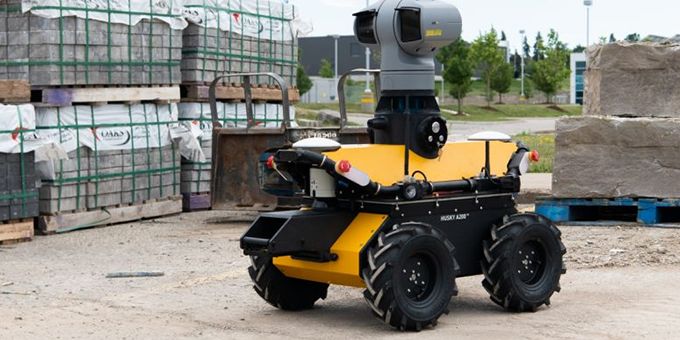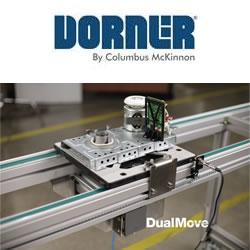“S.A.M.” will be used as a communication intermediary, connecting a superintendent with a subcontractor from across a job site through two-way communications. It will also be able to traverse the site to remotely inspect work and capture progress photography and video.
 Behind the Robot: HITT’s Construction Site Monitoring Husky UGV
Behind the Robot: HITT’s Construction Site Monitoring Husky UGV

Case Study from | Clearpath Robotics
While you might know us for our out-of-the-box ready robotic platforms, many of the robots that roll out of our shop are actually custom hardware integration projects. We believe that some of the most innovative solutions (and some of the greatest fun) are had when brainstorming in a group and creating something entirely new.
Typically, a customer brings us an ambitious idea of what they want to do with their robot and then we help them make it happen, from concept and prototyping to integration and testing. We take care of many of the time-consuming and complicated processes like systems architecture and help put together the components that your robot needs.
HITT Meets Husky UGV
Today, we wanted to share a behind-the-scenes look into a really unique integration that we did for HITT Contracting, using a Husky UGV base, lovingly nicknamed “S.A.M.”

HITT is a leading commercial general contractor with over a dozen offices across the United States providing a wide range of services—from base building construction and renovation to corporate office interior fit-outs, to smaller service and emergency work. Specifically, HITT understands that the construction industry, as a whole, struggles to attract talent for site operations roles – one of the most important roles in the entire construction project lifecycle. So naturally, many have been turning to technology to address this labor problem. As the industry looks to move work off-site or into prefabrication facilities to provide more cost control, labor productivity, and quality control, HITT believes that the industry will inevitably take on more of a manufacturing mindset and employ automation at scale.
On active job sites, for example, the environment is constantly changing with unique and different requirements than industrial or warehouse robotics. Ultimately, HITT aims to source and develop technology that equips people with the means to operate job sites more productively, in a safer manner, and with better insight into the progress of work. Hazardous work or work at heights where people have to be tied off, for example, are prime workflows that robotics could conceivably address to put people in more of a monitoring role and remove them from potential danger.

“S.A.M.”, using a Husky UGV base, is a project specifically designed for HITT’s developing internal robotics program for their site operations teams in order to equip them with the necessary tools to extend their presence on a job site, increase the team member experience, and even attract more people to field careers. Specifically, “S.A.M.” will be used as a communication intermediary, connecting a superintendent with a subcontractor from across a job site through two-way communications. It will also be able to traverse the site to remotely inspect work in place and capture progress photography and video.
Step 1: Identifying Customer Needs
The first thing that we do for any integration project is to ensure that we have a good understanding of the customer’s needs. HITT came to us looking to develop a system to act as an extension of the superintendent. This tool would allow the site superintendent to remotely communicate with different areas of the construction site, or even to areas they would not normally have access to. Such access is especially important on job sites with a large footprint, such as data centers or warehouses, or sections that might be difficult or dangerous for humans to reach.
Next, before we could start the integration, we had to consider the restrictions that the HITT team had to workaround. Many of the customers that come to us have strict requirements for things like sensor layouts in order to achieve specific tasks while other customers are more open to letting integrators like us decide how to place sensors on the robots. Some sensors, such as cameras or LIDARs, need to be unobstructed by other objects mounted on the robot. This can pose a challenge if multiple sensors must go on a robot as the integrator must figure out how to consider and integrate each component to maximize the capabilities of the vehicle that the customer is looking for.
The most important operational requirements that HITT came to us with were the following:
- Microphone and speaker on the system to allow two-way communication between the field and the remote operator
- An HD quality PTZ camera for video/photo recording
- GPS Waypoint capability for autonomous outdoor navigation
- Teleoperation by site operators
Step 2: Assembling Required Hardware

Once we collected these requirements, our integration team began creating Husky UGV’s hardware stack. For our sensor, camera, and battery needs we compiled the following components:
- Upgraded Lithium-Ion battery packs
- 1x pan-tilt-zoom camera
- 1x 3D LIDAR
- 2x hazard cameras
- 4x negative obstacle detection sensors
- 1x 2D LIDAR
- 1x IMU
- 3x GPS receivers
For battery charging, we included a wireless charging system (with receiver), whereas for audio we integrated a microphone and an audio amplifier. Finally, for networking, we included a point-to-point long-range networking module and a long-range antenna. Ultimately, the majority of components used in the system were chosen as they are standard pieces for our team’s past projects. We have seen great success with the performance of these components, as well as reliability, and therefore we were confident in adding them to this build. For this specific project, there were a few new pieces of equipment that were chosen due to the customer-specific requirements:
1. Pan-tilt-zoom Camera
The customer required a robust, HD-quality PTZ camera (360 degree capable) mounted on their robot. Internally, we required the camera to meet baseline environmental protection specs while being integratable with our Outdoor Navigation Software. Most importantly, we required a camera that met our physical placement requirements on Husky UGV (clearance, field of view, orientation, etc.).

2. Wireless Charging
The charging system was included in the initial integration proposal and was a great testbed to extend the work that we had done on Jackal UGV to our Husky UGV platform.

3. Long-range Networking
We required a networking solution that would allow us to communicate over long-range from our Operator Control Unit, through the base station, and to Husky UGV. Latency and throughput were critical criteria for this selection, as they have an outsized impact on the user experience (especially while using Teleoperation). The use of these components allowed us to achieve a usable user experience at distances up to 1km between the base station and Husky UGV.
Finally, on the software side of the build, the Husky UGV-based “S.A.M.” was equipped with our Teleoperation Navigation Package, as well as our GPS Waypoint Navigation package.

Our Teleoperation Software Package is a hardware and software kit that enables live camera and other sensor data feeds to be transmitted from the robot to a local or remote operator with robust communication, intuitive control, and seamless data collection. Our GPS Waypoint Navigation package, on the other hand, allows users to select a GPS waypoint or series of waypoints from a workstation, and direct a robot to autonomously travel between the points, with support for obstacle detection.
Step 3: Adapting to Challenges on the Fly
Like any custom project, however, this build didn’t come without its challenges. The integration of the wireless charging and battery solution proved to be more difficult than originally intended as this was a specific hardware match that we had previously not used. But ultimately, our engineering team worked in close conjunction with our supplier’s engineering teams in order to get the system running reliably.

The tuning of the networking system was also challenging. There are many different aspects to a wireless network that must be optimized in order to ensure reliable performance (transceiver locations/power, antenna locations, external interferences, etc.). We iterated the system during development to determine the optimal mix and locations of the components. This was a juggling act between customer requirements, industrial design, and performance/reliability. In the end, we settled on an optimized solution that balanced all of the competing factors.
While this project certainly came with many unique requirements, there is always a great feeling of satisfaction when we are presented with a challenge like this and can come up with a solution that is not only functional but one that looks great as well. In the end, this was a fun project to have taken on because of the challenges involved in its design and assembly as well as knowing the final application of where this robot will end up!
HITT plans to continue to experiment on various types of construction job sites, gathering feedback from users of the tool – their site operations teams. They’re also working with our team on an iteration, based on testing the POC already. Simultaneously, HITT is building the program to support the use of the tool ongoing, including maintenance plans, operator training, safety requirements, shipping and logistics, and other aspects that will make the program successful.
To learn more about Husky UGV, visit our website here.
To learn more about our GPS Waypoint Navigation Package, visit our website here.
To learn more about our Teleoperation software, visit our website here.
To learn more about HITT Contracting, visit their website here.
To learn more about custom robot engineering services, visit our website here.
The content & opinions in this article are the author’s and do not necessarily represent the views of RoboticsTomorrow
Comments (0)
This post does not have any comments. Be the first to leave a comment below.
Featured Product

